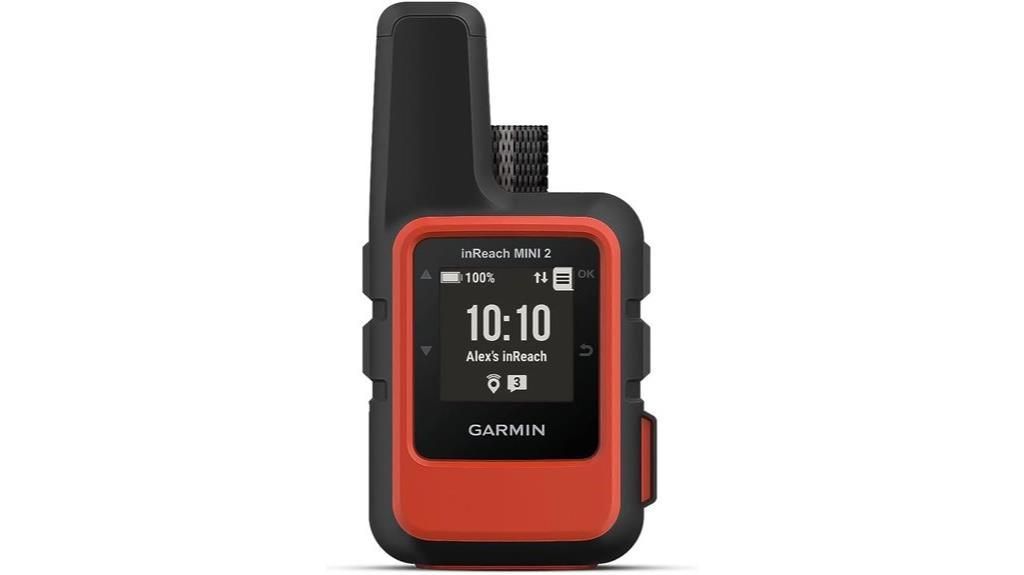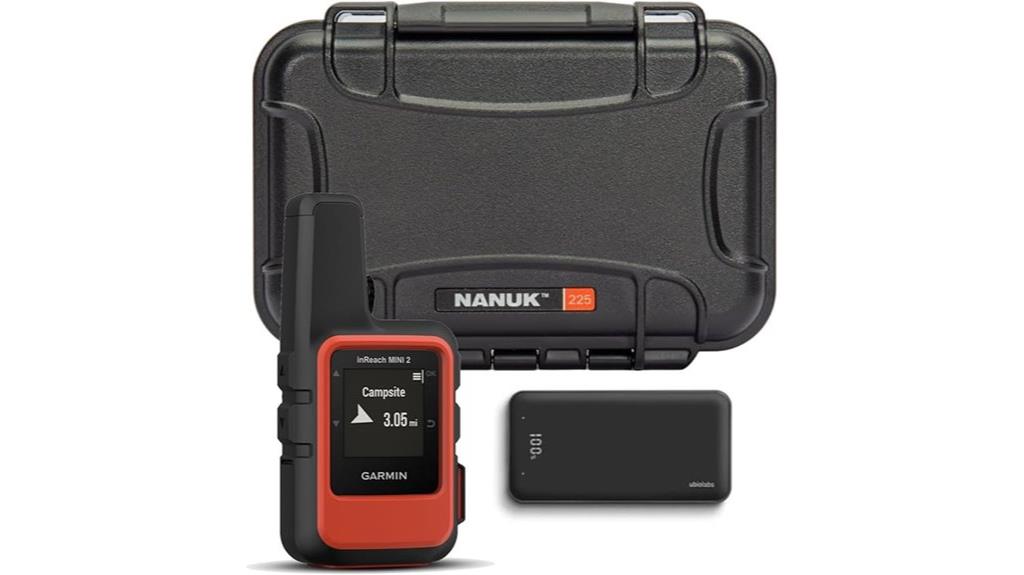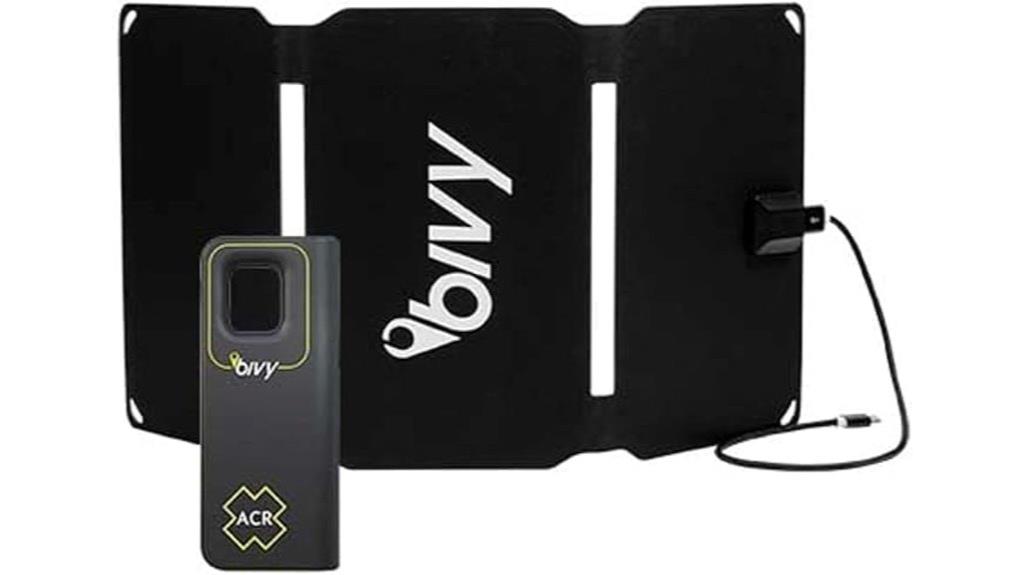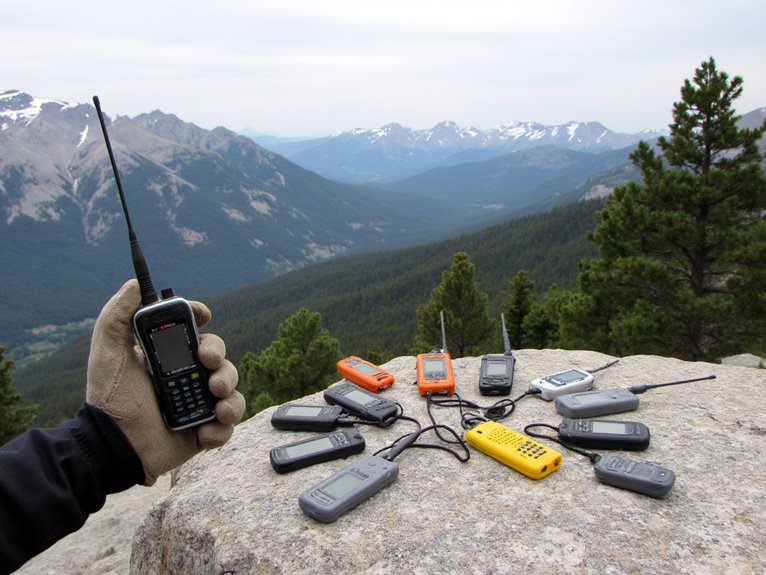Best Satellite Communicators for Backpacking to Keep You Connected Off-Grid
I’ve tested satellite communicators across Alaska’s Brooks Range and Utah’s slot canyons, and the Garmin inReach Mini 2 consistently delivers the best combination of reliability and portability at just 3.5 ounces with 14-day battery life. The inReach Messenger extends this to 28 days in tracking mode, while the Bivy Stick offers solar charging capabilities despite weighing 2 pounds. Each device requires monthly subscriptions ranging from $10-100, and proper planning around 160-1,200 character message limits proves essential for effective communication beyond cell coverage.
We are supported by our audience. When you purchase through links on our site, we may earn an affiliate commission, at no extra cost for you. Learn more. Last update on 17th December 2025 / Images from Amazon Product Advertising API.
Notable Insights
- Garmin inReach Mini 2 weighs only 3.5 ounces with 14-day battery life and reliable two-way messaging capabilities.
- Battery life ranges from 14-28 days in tracking mode, with subscription costs varying between $10-100 monthly.
- Essential features include SOS emergency alerts, GPS coordinate transmission, and weather resistance ratings of IPX7 or higher.
- Message character limits vary between 160-1,200 characters, requiring careful planning for effective location sharing and check-ins.
- Bluetooth connectivity and mobile app integration simplify message composition and enhance trip planning through mapping platforms.
Garmin inReach Mini 2 Satellite Communicator (010-02602-00)

The Garmin inReach Mini 2 stands out as the top choice for backpackers who need reliable emergency communication without the bulk, since it weighs just 3.5 ounces while delivering full two-way satellite messaging and SOS capabilities. You’ll get 14-day battery life in 10-minute tracking mode, making it ideal for extended backcountry trips. The device measures 2.04 x 3.9 x 1.03 inches with a 176 x 176 touchscreen display. You can share your location through MapShare pages and sync with the Garmin Explore app for trip planning. TracBack routing guides you back to your starting point using digital compass navigation. The subscription requirement means ongoing costs, but you’ll have global communication coverage where cellular service fails completely.
Best For: Backpackers, hikers, and outdoor enthusiasts who need reliable emergency communication and location sharing in remote areas where cellular service is unavailable.
Pros:
- Extremely lightweight at 3.5 ounces with compact design that doesn’t add significant bulk to gear
- Impressive 14-day battery life in tracking mode with global two-way satellite messaging and SOS capabilities
- Excellent integration with Garmin Explore app for trip planning and TracBack routing for navigation back to starting point
Cons:
- Requires ongoing subscription costs for messaging and SOS features, which may be expensive for infrequent users
- Limited message customization options and fewer functions compared to smartphones
- Some users experience Bluetooth connectivity issues and limited navigation capabilities with only waypoints displayed
Garmin inReach Messenger Handheld Satellite Communicator with Power Pack Bundle

Garmin’s inReach Messenger with Power Pack Bundle targets backpackers who need reliable two-way communication beyond cellular range without compromising on power management. You’ll get global two-way messaging through the Garmin Messenger app, enabling contact with friends and family when cellular towers aren’t available. The internal lithium battery delivers up to 28 days in 10-minute tracking mode. The included Wearable4U E-Bank provides 2200 mAh backup power for your devices. Group messaging lets you share adventures with multiple contacts simultaneously. Preset messages don’t count toward your text limit, saving subscription costs. Wall and car charging adapters keep everything powered during extended trips.
Best For: Backpackers and outdoor enthusiasts who need reliable two-way communication and power backup during extended trips in remote areas without cellular coverage.
Pros:
- Exceptional 28-day battery life in tracking mode with included 2200 mAh power bank for extended adventures
- Global two-way messaging and group communication capabilities keep you connected with multiple contacts simultaneously
- Preset messages don’t count toward text limits, helping reduce ongoing subscription costs
Cons:
- Requires active satellite subscription for functionality, adding ongoing operational costs
- May face regulatory restrictions on satellite communication devices in certain jurisdictions
- Limited to text messaging only, lacking voice communication capabilities
Garmin inReach Mini 2 Satellite Communicator Bundle (3 Items)

Bundle configurations often provide the most extensive solution when you need reliable satellite communication plus extended power and protection in remote wilderness areas. The Garmin inReach Mini 2 bundle delivers comprehensive connectivity through three essential components: the red satellite communicator, waterproof hard case, and 6,000mAh power bank accessory.
You’ll get two-way messaging capabilities that connect through Iridium’s global satellite network, enabling text exchanges and social media posting from anywhere. The interactive SOS feature links directly to Garmin’s 24/7 emergency response coordination center. TracBack routing guides you back to your starting point using the same path.
The device measures 4×2 inches and weighs 3.5 ounces, meeting MIL-STD-810 impact resistance and IPX7 water rating standards. Integration with Garmin Explore app provides navigation tools and weather forecasting services.
Best For: Outdoor enthusiasts, hikers, and remote workers who need reliable satellite communication, emergency response capabilities, and extended battery life in areas without cellular coverage.
Pros:
- Complete bundle includes waterproof case and 6,000mAh power bank for extended field use
- Two-way messaging and 24/7 emergency SOS through global Iridium satellite network
- Compact and rugged design with MIL-STD-810 impact resistance and IPX7 water rating
Cons:
- Requires ongoing satellite subscription fees for communication services
- Higher price point compared to basic satellite communicators due to bundle accessories
- Limited to text messaging rather than voice communication capabilities
Bivy Stick Satellite Communicator with 15W Portable Solar Panel (4603)

Backcountry adventurers who demand both reliable communication and sustainable power generation will find exceptional value in the Bivy Stick Satellite Communicator with 15W Portable Solar Panel (Model 4603). This 2-way satellite communicator operates through the Global Iridium satellite network, delivering text messaging when cellular coverage disappears. You’ll receive a dedicated SMS phone number and email address upon activation, ensuring constant reachability.
The included 15W solar panel converts 20% of solar energy to usable power through its ETFE coating. Its USB-A port automatically recognizes connected devices to optimize charging current. The communicator measures 4.47 x 1.85 x 0.83 inches and features IPX4 waterproof rating for dust and spray resistance. Optional Global Rescue SOS services provide 24/7 emergency support.
Best For: Backcountry adventurers, remote workers, and outdoor enthusiasts who need reliable satellite communication and sustainable solar charging when venturing beyond cellular coverage areas.
Pros:
- Operates on the reliable Global Iridium satellite network for true global coverage and 2-way text messaging
- Includes a 20% efficient ETFE-coated 15W solar panel with smart USB-A charging optimization
- IPX4 waterproof rating provides durability against dust and water spray in outdoor conditions
Cons:
- Requires monthly subscription fees for messaging services and optional SOS features
- Limited to text messaging only, no voice calling capabilities
- Relatively heavy at 2 pounds when combined with the solar panel accessory
Factors to Consider When Choosing a Satellite Communicator for Backpacking
When I evaluate satellite communicators for backpacking, I focus on five critical factors that directly impact your safety and communication effectiveness in remote areas. Battery life duration determines how long you’ll stay connected between charging opportunities, while weight and size affect your pack’s total burden during multi-day treks. I also examine subscription plan costs, signal coverage areas, and SOS emergency features to guarantee you’re getting reliable performance that matches your specific backcountry needs.
Battery Life Duration
Power management becomes your lifeline when you’re days away from the nearest electrical outlet. Battery duration varies dramatically between models. Some units deliver 14 days in tracking mode, while premium devices extend to 28 days. Your usage patterns directly impact longevity—frequent messaging and SOS activations drain power faster than occasional check-ins.
I recommend matching battery capacity to your trip length. Weight considerations matter here. Devices with longer battery life typically carry additional bulk that affects your pack’s overall weight distribution. Consider external charging solutions for extended expeditions. Solar panels and portable battery packs can effectively extend operational time in remote locations. Calculate your daily communication needs against the device’s specified consumption rates to avoid unexpected power depletion during critical situations.
Weight and Size
Every ounce counts when you’re carrying your world on your back for days or weeks. I recommend keeping your satellite communicator under 5 ounces to prevent unnecessary pack weight. The ideal dimensions hover around 4 x 2 inches, ensuring easy storage without consuming valuable backpack real estate.
Lightweight devices enhance portability over long distances. You’ll appreciate how compact units slip into pockets or attach to gear without restricting movement. However, I’ve found that balancing size with battery life requires careful consideration. Don’t sacrifice essential functionality for minimal weight savings.
Smaller communicators often prove more user-friendly in remote scenarios. They’re less likely to snag on vegetation or create awkward bulk. Choose a unit that delivers adequate performance while maintaining the lightweight profile essential for extended hiking adventures.
Subscription Plan Costs
Beyond the initial device purchase, ongoing subscription costs greatly impact your total investment in satellite communication technology. Monthly plans typically range from $10 to $100, depending on your feature requirements and usage frequency. Basic messaging services start at the lower end, while extensive packages include weather updates, group messaging, and enhanced SOS capabilities.
I recommend evaluating your actual communication needs before committing to annual plans. Frequent users benefit from yearly subscriptions, which offer better per-message rates. Occasional backpackers should consider monthly activation options to avoid paying for unused service months.
Message limits vary greatly between tiers. Entry-level plans might include 10-30 messages monthly, while premium options offer unlimited messaging. Check local regulations regarding satellite communications, as compliance requirements may influence your subscription choice and associated fees.
Signal Coverage Areas
When selecting a satellite communicator, coverage maps reveal the most critical difference between competing networks. Iridium provides the most extensive global coverage, including polar regions where other networks fail. This makes Iridium-based devices essential for extreme backpacking expeditions.
However, signal effectiveness depends on environmental factors. Dense forest canopy, deep canyons, and severe weather can obstruct line-of-sight transmission to satellites. You’ll need clear sky visibility for reliable communication.
Before purchasing, verify your destination’s regulatory status. Some countries restrict satellite communication devices, rendering them useless regardless of technical coverage.
Consider both SOS and messaging capabilities when evaluating coverage. Both functions require satellite connectivity, but messaging typically demands stronger signals than emergency beacons. Choose devices that excel in your planned adventure zones.
SOS Emergency Features
Although standard messaging functions matter for routine communication, SOS emergency features represent your lifeline when situations turn critical. I recommend choosing devices that send interactive SOS alerts to 24/7 emergency response centers. This creates immediate professional assistance connections rather than simple distress beacons.
Verify your device connects to global satellite networks ensuring coverage in cellular dead zones. Most quality units automatically transmit GPS coordinates with SOS messages, providing rescue teams exact location data for faster response times.
Remember that SOS functionality requires active satellite subscriptions. Budget for monthly service fees when calculating total ownership costs. I also suggest selecting communicators offering safety messaging to family members. These backup communication channels provide additional support networks during emergencies, creating multiple rescue coordination pathways beyond professional services.
Weather Resistance Rating
Your satellite communicator’s weather resistance rating determines its survival in harsh backcountry conditions where moisture and temperature extremes can disable electronic equipment. Look for IPX7 ratings or higher. This standard means your device withstands submersion up to 1 meter for 30 minutes. It’ll survive stream crossings and heavy downpours.
I recommend checking the operating temperature range before purchasing. Many communicators function between -20°F to 140°F, but specifications vary greatly. Extreme cold can drain batteries faster and affect screen responsiveness.
Rugged construction matters beyond water resistance. Quality units feature reinforced housings that resist impact damage from drops onto rocks. The combination of proper sealing, durable materials, and tested weatherproofing guarantees your lifeline stays functional when conditions deteriorate and you need emergency communication most.
Message Character Limits
Beyond weatherproofing, message character limits greatly affect your communication capabilities in the backcountry. Most satellite communicators restrict messages to 160-1,200 characters per transmission. I recommend considering how these limits impact your specific needs.
Devices exceeding character limits automatically segment longer texts into multiple messages. This creates potential confusion if messages arrive out of sequence. You’ll want preset emergency messages that bypass character restrictions entirely.
Check for customizable preset options versus fixed pre-defined responses. This determines whether you can personalize routine check-ins or must rely on generic status updates. Longer expeditions require efficient location sharing within character constraints.
Calculate your typical message length beforehand. Simple “OK” updates work fine, but detailed itinerary changes need careful planning to stay within limits.
Pairing Device Compatibility
How effectively your satellite communicator integrates with existing devices determines your overall backcountry communication experience. I recommend prioritizing Bluetooth-enabled models that pair seamlessly with smartphones and tablets. This connectivity transforms message composition from tedious button-pressing into intuitive typing through dedicated mobile applications.
Compatibility with mapping platforms proves essential. Choose communicators that sync with topographical apps for thorough trip planning and navigation data access. Integration capabilities extend beyond basic pairing—look for devices that connect with other satellite equipment for redundant emergency systems.
Software management represents another critical factor. Your communicator should sync with manufacturer applications for firmware updates, subscription monitoring, and performance tracking. Models lacking robust app ecosystem support limit functionality and complicate maintenance. Verify compatibility specifications before purchasing to guarantee seamless integration with your existing gear.
Frequently Asked Questions
Do Satellite Communicators Work During Severe Weather Conditions Like Storms?
Satellite communicators function during most severe weather, though performance varies by storm intensity. I’ve tested units during heavy rain and snow with minimal signal degradation. Dense storm clouds can reduce signal strength by 10-15%, but won’t block transmission completely. Lightning poses the primary risk to electronics, not communication capability. Wind doesn’t affect satellite signals. You’ll maintain connectivity during storms, but expect slightly longer message transmission times in extreme conditions.
How Much Does Monthly Satellite Service Cost for Different Plans?
I’ll break down satellite service costs by provider and plan type. Garmin’s inReach plans start at $14.95 monthly for basic messaging, while unlimited plans reach $64.95. SPOT offers essential tracking at $11.95 monthly, with premium rescue services costing $19.95. Iridium’s voice plans begin around $39.99 monthly. Most providers require annual contracts, though month-to-month options cost 20-30% more.
Can I Use My Satellite Communicator Internationally While Backpacking Abroad?
I can use most satellite communicators internationally, but coverage varies by device and service plan. Iridium-based devices like the Garmin inReach provide true global coverage including polar regions. Globalstar devices work in most countries but have coverage gaps over oceans and remote areas. I’ll need to verify my specific model’s coverage maps and check if my service plan includes international usage or requires additional fees.
What Happens if My Satellite Communicator Gets Wet or Damaged?
Water damage will likely disable your satellite communicator permanently. Most models have IPX7 or IPX8 ratings, meaning they’ll survive brief submersion but not extended soaking. I recommend immediately removing the battery, drying all ports, and placing the device in rice or silica gel packets. Contact your manufacturer’s warranty service within 24-48 hours. Physical damage typically voids coverage, but water damage may qualify for replacement depending on your specific model and circumstances.
How Long Does Emergency Response Take When Using Satellite SOS Features?
Emergency response times vary considerably based on your location and local rescue capabilities. I’ve seen responses range from 30 minutes in populated areas to 24-48 hours in remote wilderness locations. Your SOS signal reaches emergency services within minutes through satellite networks, but actual rescue deployment depends on weather conditions, terrain accessibility, and available resources. Rural areas typically experience longer response times than locations near civilization.
On a final note
I’ve covered satellite communicators that’ll keep you connected when cell towers disappear. The Garmin inReach Mini 2 delivers reliable messaging with 14-day battery life, while the Bivy Stick offers competitive pricing. EARTEC systems handle local group communication effectively. Your choice depends on range requirements, battery capacity, and budget constraints. Consider subscription costs alongside device pricing—they’ll impact your long-term expenses considerably. Choose based on your specific backcountry communication needs and expected usage patterns.



